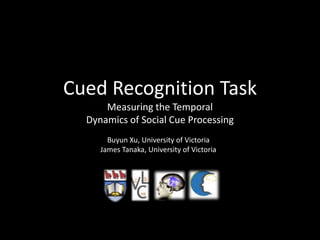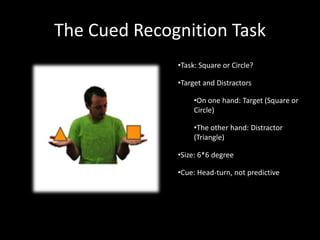Cued recognition task i slc-buyun xu
- 1. Cued Recognition Task Measuring the Temporal Dynamics of Social Cue Processing Buyun Xu, University of Victoria James Tanaka, University of Victoria
- 2. How to Study Social Cue Processing T Time Time Valid Cueing: Invalid Cueing: F SOA
- 6. Object Recognition ? ? ? ? ?
- 8. Looking at youŌĆ” Not looking at youŌĆ”
- 9. Looking at youŌĆ” Not looking at youŌĆ” Head Direction and Gaze Direction
- 11. F
- 13. DF H Distractor
- 14. Three Modifications ŌĆó Head turns ŌĆó Cues not preselected ŌĆó Distractors
- 15. The Cued Recognition Task ŌĆóTask: Square or Circle? ŌĆóTarget and Distractors ŌĆóOn one hand: Target (Square or Circle) ŌĆóThe other hand: Distractor (Triangle) ŌĆóSize: 6*6 degree ŌĆóCue: Head-turn, not predictive
- 16. 600 or 1000ms SOA 0 ms, 105 ms, 300ms, 600ms or 1005 ms Until Response Valid Invalid ŌĆ£SŌĆØ for Square ŌĆ£CŌĆØ for Circle 1000ms Cued Recognition Task
- 17. Does distractors have effects?
- 18. 600 or 1000ms 0 ms, 105 ms, 300ms, 600ms or 1005 ms Until Response ŌĆ£SŌĆØ ŌĆ£CŌĆØ 1000ms Non-DistractorDistractor Valid Invalid Valid Invalid
- 19. Non-Distractor, Valid, Short SOA
- 20. Distractor, Invalid, Long SOA
- 21. Distractor vs. Non-Distractor 450 500 550 600 650 0 105 300 600 1005 Valid Invalid 450 500 550 600 650 Non-Distractor Distractor **** **** ** ** Xu, Tanaka, Mineault, 2012
- 22. WhatŌĆÖs Really Going on?
- 24. 105 ms
- 25. 300 ms
- 26. 600 ms
- 27. 1005 ms
- 28. AOI * SOA 0% 5% 10% 15% 20% 25% 30% 35% 40% 45% 105 300 600 1005 Face Gazed NotGazed Middle
- 29. The 1005 ms of SOA 3 Fixations on averageŌĆ”
- 30. The 1st Fixation (n=6788)
- 31. The 2nd Fixation (n=2865)
- 33. Ultimate Goal Measure social cue processing of children with Autism Spectrum Disorder
- 34. Acknowledgments Allison McGerrigle iSLC, TDLC, PEN CSC Kristy Mineault
- 35. QUESTIONS?
Editor's Notes
- #4: -Most of the studies found that kids with autism respond reflexively to eye gaze cues, just as typically developed children.-It contradicts the widely accepted notion that children with autism do not engage in joint attention behaviors, such as following someoneŌĆÖs eye gaze.
- #5: Highly complex social scenesŌĆ”
- #6: Head Directions Expresses Intention and interests of the individual
- #7: Head Directions Expresses Intention and interests of the individual
- #8: Head Directions Expresses Intention and interests of the individual
- #11: Symmetrical interference effect.
- #20: MixedStronger cueing effect in Distractor condition?
- #25: corneal reflection average fixation location accuracy between 0.25˚ and 0.50˚



































